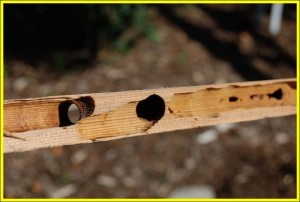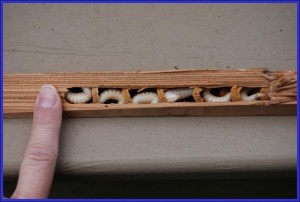
Carpenter Bees
Carpenter bees (Xylocopa and Ceratina species)
The most common carpenter bee in Michigan resembles many of the closely related, large yellow and black bumblebees we have here. The top of the abdomen of carpenter bees is bare and shiny whereas the abdomen of bumblebees is covered with black and yellow hairs. Other species of carpenter bees may be black, green or somewhat purplish with various markings of whitish, yellowish, or reddish hairs, and may be considerably smaller. Carpenter bees can be serious wood destroying insects if they choose your home to build their nest galleries. The tunnel created by the boring bee is so perfectly round that it appears to have been drilled by a tool. Carpenter bees seem to prefer softwoods like cedar, redwood and clear pines used in window trim, screens, soffits and fascia boards, and decks. These bees do not eat wood like a termite does but they use their galleries to raise their young. Each larva is provisioned with a ball of pollen and sealed into a single cell until it completes its development the following spring. Most species of carpenter bees in Michigan have a single generation per year.
Carpenter bees can be controlled by applying a registered insecticide to the gallery opening. If only one or two gallery openings are involved then an aerosol Bee and Wasp spray should be enough to kill off the bees. If large areas are affected then a persistent insecticide like cyfluthrin (sold as Bayer Advanced Garden Insect Control for homeowners or Tempo for commercial applicators) can be used to treat the entire area. Painting or otherwise sealing the wood is reported to discourage the bees from chewing their holes.
Be sure to read and follow all the instructions and safety precautions found on the pesticide label before using any pesticide. (Xylocopa and Ceratina species)
The most common carpenter bee in Michigan resembles many of the closely related, large yellow and black bumblebees we have here. The top of the abdomen of carpenter bees is bare and shiny whereas the abdomen of bumblebees is covered with black and yellow hairs. Other species of carpenter bees may be black, green or somewhat purplish with various markings of whitish, yellowish, or reddish hairs, and may be considerably smaller. Carpenter bees can be serious wood destroying insects if they choose your home to build their nest galleries. The tunnel created by the boring bee is so perfectly round that it appears to have been drilled by a tool. Carpenter bees seem to prefer softwoods like cedar, redwood and clear pines used in window trim, screens, soffits and fascia boards, and decks. These bees do not eat wood like a termite does but they use their galleries to raise their young. Each larva is provisioned with a ball of pollen and sealed into a single cell until it completes its development the following spring. Most species of carpenter bees in Michigan have a single generation per year.
Carpenter bees can be controlled by applying a registered insecticide to the gallery opening. If only one or two gallery openings are involved then an aerosol Bee and Wasp spray should be enough to kill off the bees. If large areas are affected then a persistent insecticide like cyfluthrin (sold as Bayer Advanced Garden Insect Control for homeowners or Tempo for commercial applicators) can be used to treat the entire area. Painting or otherwise sealing the wood is reported to discourage the bees from chewing their holes.
Be sure to read and follow all the instructions and safety precautions found on the pesticide label before using any pesticide.






 Print
Print Email
Email




